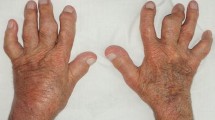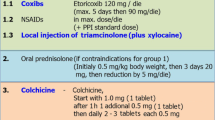Abstract
Gout in the elderly differs from classical gout found in middle-aged men in several respects: it has a more equal gender distribution, frequent polyarticular presentation with involvement of the joints of the upper extremities, fewer acute gouty episodes, a more indolent chronic clinical course, and an increased incidence of tophi. Long term diuretic use in patients with hypertension or congestive cardiac failure, renal insufficiency, prophylactic low dose aspirin (acetylsalicylic acid), and alcohol (ethanol) abuse (particularly by men) are factors associated with the development of hyperuricaemia and gout in the elderly.
Extreme caution is necessary when prescribing nonsteroidal anti-inflammatory drugs (NSAIDs) for the treatment of acute gouty arthritis in the elderly. NSAIDs with short plasma half-life (such as diclofenac and ketoprofen) are preferred, but these drugs are not recommended in patients with peptic ulcer disease, renal failure, uncontrolled hypertension or cardiac failure. Colchicine is poorly tolerated in the elderly and is best avoided. Intra-articular and systemic corticosteroids are increasingly being used for treating acute gouty flares in aged patients with medical disorders contraindicating NSAID therapy.
Urate-lowering drugs are indicated for the treatment of hyperuricaemia and chronic gouty arthritis. Uricosuric drugs are poorly tolerated and the frequent presence of renal impairment in the elderly renders these drugs ineffective. Allopurinol is the urate-lowering drug of choice, but its use in the aged is associated with an increased incidence of both cutaneous and severe hypersensitivity reactions. To minimise this risk, allopurinol dose must be kept low. A starting dose of allopurinal 50 to 100mg on alternate days, to a maximum daily dose of about 100 to 300mg, based upon the patient’s creatinine clearance and serum urate level, is recommended. Asymptomatic hyperuricaemia is not an indication for long term urate-lowering therapy; the risks of drug toxicity often outweigh any benefit.
Similar content being viewed by others
References
Ross GA, Seegmiller JE. Hyperuricemia and gout: classification, complications and management. N Engl J Med 1979; 300: 1459–68
Becker MA. Clinical aspects of monosodium urate monohydrate crystal deposition disease gout. Rheum Dis Clin North Am 1988; 14: 377–94
Fam AG. Hyperuricemia and gout. In: Rakel RE, editor. Conn’s current therapy. 51st ed. Philadelphia: W.B. Saunders Co. In press
Fam AG. Pathogenesis of hyperuricemia in patients with primary gout. Prim Care 1997; 8(1): 8–10
Dieppe PA. Investigation and management of gout in the young and the elderly. Ann Rheum Dis 1991; 50: 263–6
Wolfe F Gout and hyperuricemia. Am Fam Physician 1991; 43: 2141–50
McCarty DJ. Gout without hyperuricemia. JAMA 1994; 271: 302–3
Wallace SL, Singer JZ. Therapy in gout. Rheum Dis Clin North Am 1988; 14: 441–57
Fam AG. Strategies and controversies in the treatment of gout and hyperuricemia. Baillieres Clin Rheumatol 1990; 42: 177–92
Grahame R, Scott JT. Clinical survey of 354 patients with gout. Ann Rheum Dis 1970; 29: 461–8
Borg EJT, Rasker JJ. Gout in the elderly, a separate entity? Ann Rheum Dis 1987; 46: 72–6
Macfarlane DG, Dieppe PA. Diuretic-induced gout in elderly women. Br J Rheumatol 1985; 24: 155–7
Doherty M, Dieppe PA. Crystal deposition disease in the elderly. Clin Rheum Dis 1986: 12; 97–116
Lally EV, Zimmermann B, Ho Jr G, et al. Urate-mediated inflammation in nodal osteoarthritis: clinical and roentgenographic correlations. Arthritis Rheum 1989; 32: 86–90
Meyers OL, Monteagudo FSE. A comparison of gout in men and women: a 10-year experience. S Afr Med J 1986; 70: 721–3
Campbell SM. Gout: how presentation, diagnosis, and treatment differ in the elderly. Geriatrics 1988; 43: 71–7
Puig JG, Mateos FA, Miranda ME, et al. Purine metabolism in women with primary gout. Am J Med 1994; 97: 332–8
Fam AG, Stein J, Rubenstein J. Gouty arthritis in nodal osteoarthritis. J Rheumatol 1996; 23: 684–9
Platt PN, Dick WC. Diuretic-induced gout: the beginnings of an epidemic. Practitioner 1985; 229: 281–4
Michet Jr CJ, Evans JM, Fleming KC, et al. Common rheumatologic diseases in elderly patients. Mayo Clin Proc 1995; 70: 1205–14
Gurwitz JH, Kalish SC, Bohn RL, et al. Thiazide diuretics and the initiation of anti-gout therapy. J Clin Epidemiol 1997; 50(8): 953–9
Scott JT, Higgens CS. Diuretic-induced gout: a multifactorial condition. Ann Rheum Dis 1992; 51: 259–61
Simkin PA, Campbell PM, Larson EB. Gout in Heberden’s nodes. Arthritis Rheum 1983, 26: 94–7
McCarty DJ. Intractable gouty arthritis. Hosp Pract 1987; 22: 191–209
Fam AG. ‘Problem’ gout: clinical challenges, effective solutions. J Musculoskelet Med 1997; 14(10): 63–77
Pascual E. Persistence of monosodium urate crystals and low-grade inflammation in the synovial fluid of patients with untreated gout. Arthritis Rheum 1991; 34: 141–5
Wolfe F. Gout and hyperuricemia. Am Fam Physician 1991; 43: 2141–50
McCarty DJ. Gout without hyperuricemia. JAMA 1994; 271: 302–3
Wallace SL, Singer JZ. Therapy in gout. Rheum Dis Clin North Am 1988; 14: 441–57
Fam AG. Strategies and controversies in the treatment of gout and hyperuricemia. Baillieres Clin Rheumatol 1990; 42: 177–92
Emmerson BT. The management of gout. N Engl J Med 1996; 334: 445–51
Fam AG. Current therapy of acute microcrystalline arthritis and the role of corticosteroids. JCR: J Clin Rheumatol 1997; 3: 35–40
Ahern MJ, Rid C, Gorton TP, et al. Does colchicine work? The results of the first controlled study in acute gout. Aust N Z J Med 1987; 17: 301–4
Conaghan PG, Day RO. Risks and benefits of drugs used in the management and prevention of gout. Drug Saf 1994; 11(4): 252–8
Roberts WN, Liang MH, Stern SH. Colchicine in acute gout: reassessment of risks and benefits. JAMA 1987; 257: 1920–2
Wallace SL, Singer JZ. Review: systemic toxicity associated with the intravenous administration of colchicine-guidelines for use. J Rheumatol 1988; 15: 495–9
Evans IT, Wheeler MT, Small RE, et al. A comprehensive investigation of inpatient intravenous colchicine use shows more education is needed. J Rheumatol 1996; 23: 143–8
Star VL, Hochberg MC. Prevention and management of gout. Drugs 1993; 92: 1722–9
Fam AG. Should patients with interval gout be treated with urate lowering drugs [editorial]? J Rheumatol 1995; 22: 1621–3
Alloway JA, Moriarty MJ, Hoogland YT, et al. Comparison of triamcinolone acetonide with indomethacin in the treatment of acute gouty arthritis. J Rheumatol 1993; 20: 111–3
Siegel LB, Alloway JA, Nashel DJ. Comparison of adrenocorticotropic hormone and triamcinolone acetonide in the treatment of acute gouty arthritis. J Rheumatol 1994; 21: 1325–7
Groff GD, Franck WA, Raddatz DA. Systemic steroid therapy for acute gout: a clinical trial and review of the literature. Semin Arthritis Rheum 1990; 19: 329–36
Axelrod D, Preston S. Comparison of parenteral adrenocorticotropic hormone with oral indomethacin in the treatment of acute gout. Arthritis Rheum 1988; 33: 803–5
Gonzalez EB, Miller SB, Agudelo CA. Optimal management of gout in older patients. Drugs Aging 1994; 4(2): 128–34
George TM, Mandell BT. Individualizing the treatment of gout. Cleve Clin J Med 1996; 63: 150–5
Cusack BJ, Vestal RE. Geriatric clinical pharmacology and therapeutics. In: Speight TM, Holford NHG, editors. Avery’s drug treatment. 4th ed. Auckland: Adis International, 1997: 173–223
Rochon PA, Gurwitz JH. Optimizing drug treatment for elderly people: the prescribing cascade. BMJ 1997; 315: 1096–9
Henry D, Page J, Whyte I, et al. Consumption of non-steroidal anti-inflammatory drugs and the development of functional renal impairment in elderly subjects: results of a case-control study. Br J Pharmacol 1997; 44: 85–90
Segasothy M, Chin GL, Sia KK, et al. Chronic nephrotoxicity of anti-inflammatory drags used in the treatment of arthritis. Br J Rheumatol 1995; 34: 162–5
Kuncl RW, Duncan G, Watson D, et al. Colchicine myopathy and neuropathy. N Engl J Med 1987; 316: 1562–8
Ferraz MB, O’Brein B. A cost effectiveness analysis of urate lowering drugs in nontophaceous recurrent gouty arthritis. J Rheumatol 1995; 22: 908–14
Kot TV, Day RO, Brooks PM. Preventing acute gout when starting allopurinol therapy: colchicine or NSAIDs? Med J Aust 1993; 159: 182–4
Hande KR, Noone RM, Stone WJ. Severe allopurinol toxicity: description and guidelines for prevention in patients with renal insufficiency. Am J Med 1984; 76: 47–56
Murrell GAC, Rapeport WG. Clinical pharmacokinetics of allopurinol. Clin Pharmacokinet 1986; 11: 343–53
Simmonds HA, Cameron JS, Morris GS, et al. Allopurinol in renal failure and the tumour lysis syndrome. Clin Chim Acta 1986; 160: 189–95
Fam AG, Lewtas J, Stein J, et al. Desensitization to allopurinol in patients with gout and cutaneous reactions. Am J Med 1992; 93: 299–302
Cameron JS, Simmonds HA. Use and abuse of allopurinol. BMJ 1987: 294: 1505–6
Earll JM, Saavedra M. Oxipurinol therapy in allopurinol-allergic patients. Am Fam Physician 1983; 28: 147–8
Walter-Sack I, deVries JX, Ernst B, et al. Uric acid lowering effect of oxipurinol sodium in hyperuricemic patients-therapeutic equivalence to allopurinol. JRheumatol 1996; 23: 498–501
Chua CC, Greenberg ML, Viau AT, et al. Use of polyethylene glycol-modified uricase (PEG-uricase) to treat hyperuricemia in a patient with non-Hodgkin’s lymphoma. Ann Intern Med 1989; 109: 114–7
Rozenberg S, Koeger A-C, Bourgeois P. Urate-oxydase for gouty arthritis in cardiac transplant recipients [letter]. J Rheumatol 1993; 20: 2171
Kovalchik III MT. Sulfinpyrazone induced uric acid urolithiasis with acute renal failure. Conn Med 1981: 45(7): 423–4
Burack DA, Griffith BP, Thompson ME. Hyperuricemia and gout among heart transplant recipients receiving cyclosporine. Am J Med 1992; 92: 141–6
George T, Mandell BF. Gout in the transplant patient. J Clin Rheumatol 1995; 1: 328–34
Marcen R, Gallego N, Orofino L, et al. Impairment of tubular secretion of urate in renal transplant patients on cyclosporine. Nephron 1995; 70: 307–13
Cummins D, Sekar M, Halil O, et al. Myelosuppression associated with azathioprine-allopurinol interaction after heart and lung transplantation. Transplantation 1996; 61: 1661–2
Rosenthal AK, Ryan LM. Treatment of refractory crystal-associated arthritis. Rheum Dis Clin North Am 1995; 21: 151–61
McCarthy GM, Barthelemy CR, Veum JA, et al. Influence of antihyperaricemic therapy on the clinical and radiographic progression of gout. Arthritis Rheum 1991; 34: 1489–94
O’Reilly S, Doherty M. Missed opportunity following diagnosis of gout. Ann Rheum Dis 1995; 54: 86–7
Raison SH, Capell H, Sturrock RD. Alcohol and response to treatment of gout. BMJ 1988; 296: 1641–2
Emmerson BT, Gorton RB, Cross M, et al. Plasma oxipurinol concentrations during allopurinol therapy. Br J Rheumatol 1987; 26: 445–9
Day RO, Miners JO, Birkett DJ, et al. Allopurinol dosage selection: relationship between dose and plasma oxipurinol and urate concentrations and urinary urate excretion. Br J Clin Pharmacol 1988; 26: 423–8
Peterson GM, Boyle RR, Francis HW, et al. Dosage prescribing and plasma oxipurinol levels in patients receiving allopurinol therapy. Eur J Clin Pharmacol 1990; 39: 419–21
Campion EW, Glynn RJ, DeLarby LO. Asymptomatic hyperuricemia: risks and consequences in the normative aging study. Am J Med 1987; 82: 421–6
Author information
Authors and Affiliations
Rights and permissions
About this article
Cite this article
Fam, A.G. Gout in the Elderly. Drugs Aging 13, 229–243 (1998). https://doi.org/10.2165/00002512-199813030-00006
Published:
Issue Date:
DOI: https://doi.org/10.2165/00002512-199813030-00006




